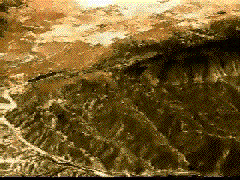

Simple model of Plate Tectonics
Problem: According to the geological theory of plate tectonics, the surface of the earth consist of 13 to 15 rigid plates that move slowly past each other on the mantle of the earth. Earthquakes an occur when the edges of the plate, originally stuck together, slip, causing a cleavage in the earth's surface. Let us estimate the size of the shear force that results in an earthquake. Consider two plates as seen from above . They move slowly pass each other in opposite direction. Friction force prevent the sides of the plates that are touching from moving. As each plate moves forward, a shearing force is caused by the force of each plate holding the other's edge in place. let us estimate roughly the magnitude of the shear force of the plate on the other. Use the following numbers, which represent, at least, the order of magnitude of quantities in the following equation to find the shear force between the plates.
Solution:
A is the area: A fault may be several hundred kilometers long ( we will use 100 km ) and extends perhaps 10 km into the ground. The area of contact between the two plates is roughly A= ( 100000 m) ( 10000 m) = 100 , 000000 square meters.
L is the length: The plate is sheared of perhaps L = 10 km on each side of the edge between two plates.
displacement delta s : The plates move at a speed of about 4 cm / year. Since major earthquakes occur roughly every 50 to 100 years, we estimate that the unimpeded part of each plate away from the fault has moved a distance of about ( 75 years ) ( 0.04 m / yr ) = 3 .
Shear modulus: A representative value of the shear modulus for rock is 300 billions Newton / square meters. Therefore from the above equation the shear force is